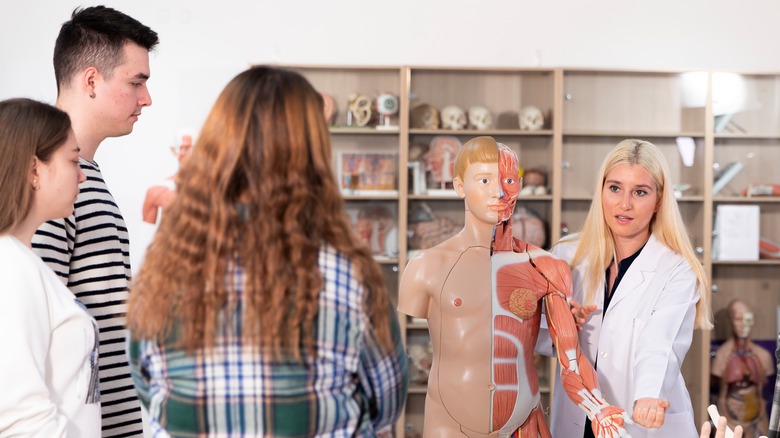Here's How To Start A Career As A Physical Therapist
Are you passionate about anatomy and exercise? Do you enjoy helping others and want to make a difference through your work? In this case, you could become a physical therapist. This career path requires fewer years of study than medicine, but it can be just as rewarding. You'd have the chance to work with athletes, children, seniors, and others who need your help — and use your skills to improve their lives.
Physical therapists are paid well, too. In 2021, they made anywhere between $61,900 and $127,100 per year, with the median wage being around $95,620, according to the U.S. Bureau of Labor Statistics. As you gain experience, you could start a private practice or go freelance and set your own rates. There's also the option to specialize in one or more areas, such as sports rehab or women's health, and take your career to a whole new level.
Generally, it takes about six to seven years to break into this industry (via Indeed). However, you may be able to work while in school to gain experience and make an income. With that in mind, here's what it takes to start your career as a physical therapist.
Plan your career path and complete training
Physical therapists help people regain mobility and prevent or ease joint pain and muscle strain, according to the American Physical Therapy Association. They usually work with patients who've had surgery or sustained injuries but can also assist those with neck or back pain, neurological damage, or chronic diseases. The job requires in-depth knowledge of human anatomy and physiology and specific skills, such as dexterity, resourcefulness, and compassion (via U.S. Bureau of Labor Statistics).
The first step to becoming a physical therapist is to earn a bachelor's degree in exercise science, athletic training, biology, or other health-related disciplines. After that, you'll have to complete a Doctor of Physical Therapy (DPT) degree program, which usually lasts around three years. The curriculum covers human anatomy, biomechanics, clinical neuroscience, patient care, and other topics. Make sure you choose a DPT program approved by the Commission on Accreditation in Physical Therapy Education.
Alternatively, you may complete a six-year program to earn a Bachelor of Science (BS) and a DPT degree. For example, the University of Hartford in Connecticut offers an accelerated BS/DPT program that combines coursework and real-world experiences, including internships. Graduates can also complete a clinical residency or fellowship at an institution accredited by the American Board of Physical Therapy Residency and Fellowship Education. This step is optional but would allow you to gain hands-on experience.
How to find work as a physical therapist
The U.S. Bureau of Labor Statistics (BLS) explains that physical therapists must get licensed before starting work. This profession requires passing an exam administered by the Federation of State Boards of Physical Therapy, plus additional tests — depending on the state. Later in your career, you may complete further training to specialize in neurology, pediatrics, sports, orthopedics, or other areas. Those who go this route are recognized as board-certified specialists and may have a competitive edge in the job market.
If you're a fresh grad, reach out to hospitals, nursing homes, clinics, or other health facilities that may need your services. Ensure you also check the job vacancies published by the American Physical Therapy Association. According to BLS, about 3% of physical therapists are self-employed, so that's an option to consider. If you enjoy traveling, try to find work on cruise ships or overseas. A good resource is Therapy Travelers, an online platform featuring physical therapy jobs in the U.S. and abroad.
Meanwhile, you could set up a website and list your services. You could also become a content writer, explaining physical rehab, injury prevention, pain science, and other related topics to demonstrate your expertise. Another option is to launch a course or eBook covering topics like pain management, common injuries, at-home exercises, and so on. Think of it as a way to make extra money and get your name out there. Also, you could offer physical therapy sessions online via Skype, Zoom, or dedicated platforms like ATI and Athletico.


